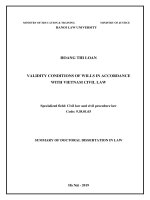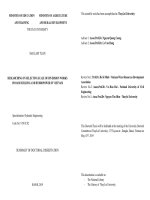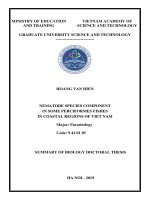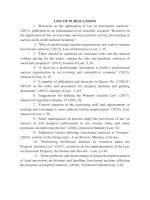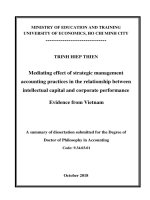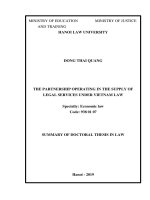Xác định và phân tích hoàn chỉnh trình tự hệ gen ty thể của 6 giống lợn bản địa tại một số tỉnh miền bắc việt nam tt tiếng anh
Bạn đang xem bản rút gọn của tài liệu. Xem và tải ngay bản đầy đủ của tài liệu tại đây (899.82 KB, 27 trang )
MINISTRY OF EDUCATION AND
TRAINING
VIETNAM ACADEMY OF
SCIENCE AND TECHNOLOGY
GRADUATE UNIVERSITY OF SCIENCE AND TECHNOLOGY
-----------------------------
Bui Anh Tuan
SEQUENCING AND ANALYSIS OF COMPLETE
MITOCHONDRIAL GENOME OF 6 INDIGENOUS PIGS
IN SOME NORTHERN PROVINCES OF VIETNAM
Major : Biotechnology
Code : 94 20 20 1
SUMMARY OF BIOLOGY DOCTORAL THESIS
Ha Noi - 2020
The research was completed in
Graduate University of Science and Technology - Vietnam Academy
of Science and Technology
Scientific supervisor 1: Prof., Dr. Nghiem Ngoc Minh
Scientific supervisor 2: Assoc. Prof., Dr. Vo Thi Bich Thuy
Reviewer 1:
Reviewer 2:
Reviewer 3:
The thesis will be defended in front of the graduate university's
doctoral thesis evaluation council, meeting at Graduate University of
Science and Technology - Vietnam Academy of Science and
Technology
At … ’, date of
…
2020
The thesis can be found at:
- Library of Graduate University of Science and Technology
- Vietnam National Library
1
INTRODUCTION
1. The necessity of the thesis
Under current breeding conditions, native pig breeds are
declining in number, losing a local and national precious gene
source, some breeds have become extinct or on the brink of
extinction. To date, there has not been a complete scientific research
on the genome of indigenous pigs in Vietnam, thereby clarifying the
origin and relationships arising from the species, in order to serve the
conservation. The establishment of molecular database on genetic
resources of these pig breeds has not yet been fully implemented and
exploited. From the above urgent issues, we conduct research on the
subject: “Sequencing and analysis of mitochondrial genome of 6
indigenous pig breeds in some Northern provinces of Vietnam".
2. Research purpose
-
Collecting complete data of mitochondrial genome of 6
indigenous pig breeds in Vietnam (I, Mong Cai, Muong Lay, Huong,
Muong Khuong and Ha Lang pigs) and deposited on the Genebank.
-
Determine the composition, structure of mitochondrial
genome, compare the difference in sequence, identify specific
genetic characteristics of the six indigenous pig breeds, thereby
contributing to the database to identification and conservation.
-
Analysis genetic relationships, determine the origin and type
of 6 indigenous pig breeds in Vietnam.
3. The main research content
- Investigating and surveying breeds, places of residence,
collecting blood samples of the six indigenous pig breeds studied.
- Complete sequencing of mitochondrial genome of six
indigenous pig breeds. Assemble, determine the complete sequence
2
of the mitochondrial genome, and annotate.
- Analysis of the composition and structure of the genome.
- Studying sequence polymorphism, comparing mitochondrial
genome sequences of these 6 pig breeds with some pig breeds in
Asia and Europe.
- Reconstructing a phylogenetic tree based on the D-loop region
sequence and the complete sequence of the mitochondrial genome,
analyzing the phylogenetic relationship between 6 Vietnamese
indigenous pig breeds and some other pig breeds in the world.
Chapter 1. LITERATURE REVIEW
1.1. Origin, classification and domestication of domestic pigs
The ancient ancestors of pigs, wild boars, were hunted to provide
food for the lives of primitive people. All current pig breeds are
considered to be the forms of Sus scrofa domestica. Evidence of
phylo-geographic showing that the domestication of pigs occurs
many times in many parts of the world. There is a view that today the
ancestors of pigs are identified as primitive wild boars and their
native land is Southeast Asia.
1.2. Application of mitochondrial genome in the study of
phylogenetic and traceability
Determining the relationship of phylogenetic using mtDNA
sequences based on the principle: information about evolution can be
obtained through analysis of sequence data. mtDNA has been widely
used for phylogenetic research for the following reasons: First, the
evolution of mtDNA in mammals takes place primarily from the
replacement of individual nucleotide pairs, which is very rare when
rearranging the major parts of the genome. Second, the evolution rate
of mtDNA is thought to be 10 times faster than that of nuclear DNA.
3
Third, mtDNA is inherited by the maternal line, is haploid and does
not occur recombinant.
1.3.
Phylogenetic tree reconstruction and analysis
1.3.1. Phylogenetic tree
A phylogenetic tree is a branched graph that represents the
evolutionary relationship between living organisms, giving a
hypothesis about how tree organisms are related. The topological
geometry of a tree determines the relationship of the entities
represented on the derived tree.. Only one branch is connected
between the two nodes. Nodes represent taxonomies (taxons that are
specific DNA or protein sequences), the node is the intersection or
end point of two or more branches. An operative taxon unit (OTU) is
an existing taxon present at an outermost node or leaf.
1.3.2. Phylogenetic analysis
Analysis of molecular phylogenetic is divided into five steps:
(1) Collecting and selecting sequences: collecting sequences from
a database containing thousands of families of eukaryotes, or results
from the BLAST tool (2) Aligning sequences: Use the sequence
alignment of a group of homologous sequences.(3) Selecting
substitution models in DNA and amino acid sequence. (4) Tree
reconstruction: There are four main methods for building trees:
based on distance, maximum parsimony, maximum likelihood, and
Bayes inference. MrBayes evaluates an a priori probability
distribution, which is the ability of a tree to satisfy observed data. (5)
Phylogenetic tree analysis: The accuracy of the tree was assessed by
bootstrap analysis.Bootstrap describes the power of topology of a
tree. Determining the root of the tree helps to assess the overall
4
direction of change. The root can be determined based on the
midpoint or by the out group.
Chapter 2. SUBJECTS AND RESEARCH METHODS
2.1. Subjects and research locations
Pigs of 6 indigenous pig breeds in Vietnam (eg, Mong Cai, Mong
Khuong, Muong Lay, Huong and Ha Lang) were randomly selected
among pig herds in some localities: Dien Bien, Lao Cai, Cao Bang,
Hai Phong and Thanh Hoa.
2.2. Research methods
2.2.1. Survey method based on pig appearance
Observe the outside of the animal by groups of fur, skin color and
evaluation criteria for the shape, characteristics of the pig's body
parts, weight measurement, indicators: body length, round chest and
high shoulders. Evaluation criteria against slices of livestock breeds
in Vietnam and Monograph on conservation and exploitation of
Vietnamese domestic animal genetic resources.
2.2.2. Sequencing mitochondrial DNA genome
DNA extraction, mtDNAfragment amplification using PCR,
Sequencing mitochondrial genome by shotgun sequencing follow
by Sanger's mothod.
2.2.3. Methods for assembling, predicting and annotating
genomes
2.2.3.1. Genome assembly
Sequence data was assessed and edited on BioEdit v7.2.5
software. Contig segments obtained from the cutting process will be
assembled based on the overlapping sequences at the ends of each
segment using DNA Dragon v1.6.0 (SequentiX) and EditSeq
(DNASTAR) software.
5
2.2.3.2. Multiple alignment
The D-loop region sequences and the coding sequences of the
assembled mitochondrial genome will be separated. The sequence of
short iterations before and after 5 '-CGTGCGTACA-3' is determined
by the number of repetition units and discarded. The mitochondrial
genome sequence of pig breeds in the world is arranged in a multisequence, using the MUSCLE algorithm. Identify the most
appropriate evolutionary model using MEGA7 software.
2.2.3.3. Genome analysis and annotation
Analysis and annotation of genome and tRNA genes of
indigenous pigs in Vietnam using Dogma and Mitos Web Server
online. All annotations were checked by BLAST tool on GenBank.
2.2.4. Sequence analysis and method of determining the level
of sequence similarity
In order to obtain the sequence we analyzed the basic indices for
asymmetric ratio of nucleotide types such as percentage of
nucleotides using DAMBE v6.3.17 software ()
.uottawa.ca /), along with two deviations: GC skew and AT skew are
calculated using the following formula:
AT skew = (A-T)/(A+T)
GC skew = (G-C)/(G+C)
2.2.5. Phelogenetic reconstructiong and analysis method
2.2.5.1. Evolutional distance
The evolutional distance (p-distance) between sequence pairs was
calculated using the two-parameter algorithm of Kimura in MEGA
software
2.2.5.2. Phylogenetic analysis
The sequence of the Dloop region and the entire coding region of
the mitochondrial genome are used separately as input data to
6
reconstruct the corresponding phylogenetic trees. Bayes method is
used in BEAST v1.8.3 software, set up Yule process and MCMC
10000000 to calculate prior probability. The optimal tree was found
using Tree Annotater v.1.8.4. The root of the tree was determined by
a method of using the out-group. Finally, Figure Tree v1.4.2 software
is used to read the output file and reconstruct the phylogenetic tree.
Chapter 3. RESULTS AND DISCUSSION
3.1. Sample selection and collection
Up to now, in Vietnam, to identify indigenous pig breeds,
breeders have not had any molecular database but mainly bases and
set of morphological indicators have been published and approved.
To ensure reliability in sampling for research, we surveyed
appearance characteristics based on 3 groups of criteria: (1)
Characteristics of fur and skin; (2) stature, weight and (3) body
shape, number of nipples.
a. Group of characteristics characteristics of fur and skin
In Muong Lay breed, it is observed that the skin color distribution
is often accompanied by some appearance indicators to form a
smaller subgroup (name: group A +). The number of pig individuals
observed in skin color was classified into A +, A and B groups in
descending order of breed characteristics. Only individuals with full
breed criteria (group A or A +) can be selected for screening in the
next target group.
Table 3.1. Survey results on fur and skin characteristics of 6
indigenous pig breeds
Characteristics on the colour of fur and
skin
I pigs
Fur is thin and coarse. Skin is black but not
glossy
Total
9
N
9
Group
A
%
100
7
Mong Cai pigs
- The body is black and white, black head,
adjacent to the black and white hairs have a
blur
- The body is black and white, the black head
in the middle of the forehead has white spots,
adjacent to the black and white hairs have
blurred space
100
82
B
82,0
18
A
18,0
77
B
77,0
23
A
23,0
22
B
57,8
16
A
42,1
13
B
31,7
28
A
68,3
Muong Khuong pigs
- Fur is pure black. The fur is thin and soft.
100
- Black fur has white spots on the tail and legs,
the fur is soft and thin.
Huong pigs
- Body and 4 legs are white with black skin on
the buttocks and scalp. The juxtaposition
between black and white is about 2-3 cm wide,
on which the skin is black, the white fur
- There are additional characteristics: in the
middle of the forehead is a white point, the four
legs are white.
38
Ha Lang pigs
- The belly is white and has a white shoulder
strap, with a black strip similar to a saddle.
- There are additional characteristics: The
forehead has a white point almost like a wedge
41
Muong Lay pigs
- Black, straight back, nipple head 10-15cm
70
35
B
50,0
above the ground
- There are more white spots on the legs,
11,4
8
A
forehead, tail, back, straight nipples 10-15 cm
2
from the face
- There is more back slightly hammock,
27
A+
38,5
slightly saggy belly, nipple head are not sag.
(N: Number of selected individuals with skin color characteristics suitable for
Slices; %: percentage of individuals with suitable characteristics on the total
number of observed individuals)
Only individuals in groups A and A + will be selected to conduct
surveys in the criteria group of stature and weight.
b. Characteristics of dimensions of dimensions and mass
8
Table 3.2. Survey results of weight and size of 6 indigenous
pigs
Pig breeds
Mass
Long body
± SD
I
Mong Cai
Huong
Ha Lang
Muong
Khuong
Muong Lay
Chest
± SD
High
shoulders
± SD
± SD
40,34 ± 0,92
51,47 ± 0,32
40,55 ± 0,22
42,68 ± 042
85,76 ± 1,32
92,41 ± 1,35
86,73 ± 1,33
87,12 ± 1,33
83,93 ± 1,44
90,77 ± 1,46
81,31 ± 1,42
84,34 ± 1,43
39,58 ± 0,91
45,25 ± 0,93
42,56 ±0,36
43,68 ±0,98
52,64 ± 0,92
93,94 ± 1,32
90,52 ± 1,46
46,14 ±0,96
40,43 ± 0,95
85,71 ± 1,38
83,97 ± 1,46
43,25±0,94
(Unit: Mass: Kg; Dimension: cm)
: Average value ± SD: standard deviation
The results showed that 100% of the individuals surveyed on the
group of criteria of stature and body size have the characteristics of
each breed.
c.
Survey on body shape criteria group
Table 3.3. Survey on body shape characteristics of 6 indigenous pigs
Body shape characteristics (number of nipples)
Total
N
%
9
9
100
18
15
83,3
23
20
86,9
I pigs
- Moderately large head, near-flat forehead, wrinkled face,
sagging neck and saggy cheeks when fat, short muzzle
- The belly is less saggy, the body, legs are long and taller
than the I Mo pigs
Mong Cai pigs
- Large head, small muzzle and long, small and pointed
ears, big and short wrinkles in the mouth.
- The neck is large and short, the chest is broad and deep,
the back is long, slightly sagging, the belly is slightly
saggy, the buttocks broad and down.
Muong Khuong pigs
- Muzzle long straight or slightly arched. The forehead is
smooth, the ear cup is hanging forward.
9
- Four big strong legs. The back is slightly curved, the belly
is big but not saggy to the ground, butt is slightly sloping.
Huong pigs
- The head is black and rough, there is a white spot
between the forehead.
- - Big feet, moderately large and not touching the ground,
back hammock but not broken, four legs are white, sloping
butt, shoulders broad, chest deep.
Ha Lang pigs
- Muzzle short, wrinkly face.
- Short legs. Back hammock, abdomen does not touch the
ground
Muong Lay pigs
- Muzzle straight, moderately long, wrinkled forehead,
large and thick ears
- Body is elongated, slightly back hammock, large and
moderately high legs
- The nipple is even, when pregnant and nursing, the
nipple does not sag, do not touch the ground.
16
10
62,5
28
25
89,2
27
13
48,1
(N: Number of individuals selected to have a body shape that is consistent
with Slic;%: percentage of individuals with an appropriate feature out of
the total observed.)
The number of individuals belonging to 6 pig breeds after being
selected through 3 groups of appearance indicators has reached all
the typical criteria of each breed. Blood samples from these
individuals were randomly selected for each of the 6 samples for
total DNA extraction for research purposes.
3.2. Mitochondrial genome sequence of 6 indigenous pigs
Complete sequences of mitochondrial genomes of 6 indigenous
pigs, including I, Mong Cai, Muong Khuong, Muong Lay, Huong
and Ha Lang, have been identified and registered on GenBank with
access numbers: KX094894, KU556691, KY432578 , KX147101,
KY964306 and KY800118. The work of the author Tran Thi Thuy
Nhien et al (2016) conducted an independent study also announced
the complete sequence of the mitochondrial genome of Mong Cai
pigs (access code GenBank: KU556691). The genome size of Mong
10
Cai pigs' genome published by this group is 16,632 bp, shorter than
the sequence in our study results of 79 bp, the difference is mainly in
the D-loop region, which has the number of repetitive motifs
'CGTGCGTACA'.
3.3. Mitochondrial genome analysis
3.3.1. Analysis of mitochondrial genome composition
The composition ratios of nucleotide types are listed in Table 3.5.
Table 3.5. Base component ratio in mitochondrial genome of 6
indigenous pigs in Vietnam
Pigs breed
I
Mong Cai
Muong Khuong
Ha Lang
Huong
Muong Lay
A(%)
34,64
34,70
34,68
34,67
34,65
34,70
C(%)
26,24
26,20
26,19
26,20
26,22
26,19
G(%)
13,33
13,30
13,31
13,32
13,352
13,32
T(%)
25,75
25,79
25,81
25,78
25,78
25,79
G+C(%)
39,57
39,50
39,50
39,55
39,57
39,51
The results show that the deviation of the mitochondrial
nucleotide genome composition of the studied pig breeds is in the
direction of A + T rich (60.43 - 60.50). Some indicators specific to
the mitochondrial genome sequence such as the percentage of base
type G and type C (% GC), GC and AT deviations (GC skew and AT
skew) are listed for analysis and comparison. between indigenous
pigs in Vietnam and other pigs in the world in Table 3.6.
Table 3.6. The sequence composition of groups of pigs in the world
Region
Vietname
se
indigeno
us Pigs
North
Pig breeds
I
Mong Cai
Ha Lang
Huong
Muong Khuong
Muong Lay
Jeju
Complete sequence
GC
AT
%GC
skew skew
39,35 -0,33 0,15
39,23 -0,33 0,15
39,24 -0,33 0,15
39,25 -0,33 0,15
39,25 -0,33 0,15
39,29 -0,33 0,15
-
D-loop sequence
GC
AT
%GC
skew skew
39,91 -0,32 0,16
38,77 -0,33 0,16
38,47 -0,34 0,16
39,25 -0,30 0,14
38,79 -0,33 0,16
39,59 -0,31 0,16
38,55 -0,35 0,17
11
East Asia Korean native pig
WB-China
39,25 -0,33 0,15
northeast
WB-Japan
WB-Korea
39,19 -0,33 0,15
Yellow
Bamei
39,21 -0,33 0,15
River
Huzu
39,2 -0,33 0,15
Valley
Berkshire
39,28 -0,33 0,15
Duroc
39,32 -0,33 0,15
Hampshire
39,33 -0,33 0,15
European Iberian
39,29 -0,34 0,15
Country
Landrace
39,28 -0,33 0,15
Large White
39,27 -0,33 0,15
Pietrain
39,28 -0,34 0,15
WB-European
39,28 -0,34 0,15
Banna mini
39,28 -0,33 0,15
Dahe
39,24 -0,33 0,15
Mekong Thailand indigenous pig
Region
WB-Malaysia
39,18 -0,33 0,15
WB-Vietnam
39,26 -0,33 0,15
WB-Yunnan
39,28 -0,33 0,15
Lantang
39,22 -0,33 0,15
South
Lanyu
39,25 -0,30 0,12
China
WB-Fujian
39,19 -0,33 0,15
WB-Hainan
39,19 -0,33 0,15
Aba
39,21 -0,33 0,15
Bihu
39,81 -0,31 0,14
Yangtze
Jinhua
39,22 -0,33 0,15
River
Kele
Region
Taoyuan
WB-Jiangxi
39,22 -0,33 0,15
Wei
39,2 -0,33 0,15
Xiang pig
39,18 -0,33 0,15
"-" : The complete sequence has not been announced.
38,76 -0,35
0,15
38,2
-0,34
0,15
39,09 -0,33
38,59 -0,33
38,69 -0,34
0,16
0,16
0,16
38,69 -0,34
0,16
38,47
38,66
38,27
38,37
38,47
38,47
38,52
38,56
39,16
38,92
38,7
38,59
38,69
39,27
38,57
38,55
38,71
38,68
38,69
38,69
38,46
38,68
38,66
38,59
38,69
38,59
0,16
0,16
0,16
0,16
0,15
0,16
0,16
0,17
0,16
0,16
0,16
0,19
0,16
0,15
0,16
0,16
0,16
0,15
0,16
0,16
0,16
0,16
0,16
0,16
0,16
0,16
-0,34
-0,35
-0,36
-0,35
-0,35
-0,35
-0,35
-0,35
-0,34
-0,33
-0,33
-0,38
-0,34
-0,31
-0,34
-0,34
-0,33
-0,33
-0,34
-0,34
-0,34
-0,34
-0,34
-0,34
-0,34
-0,33
GC skew indices are all negative for pigs, AT skew is positive.
Thus, in terms of evolution, the trend of changing the nucleotide
composition among pigs is no big difference. For the complete
sequence, all six studied pigs were similar in GC skew and AT skew
values with values of -0.33 and 0.15 respectively.
12
In Huong and Muong Lay breeds with Chinese WB-Yunnan, the
complete sequence has the least difference between C and G
respectively 0.30 and 0.31. The pigs Huong breed has the lowest
deviation between the two types of nucleotides A and T (0.14).
Comparison between the D-loop sequence and the complete
sequence, it can be seen that the D-loop region in most pigs has
higher AT skew, that is, the level of nucleotide conversion of type A
and T higher. The average value of the GC skew value for
Vietnamese native pigs (-0.32) is higher than the average for other
pigs in the world (-0.34). Theoretically, these deviation indicators
also allow a partial assessment of genetic diversity and indirectly
identify the relationships of phylogenetic. However, the difference is
not large enough between the research subjects, so it is not possible
to draw any specific scientific reasoning in the two directions from
the GC skew and AT skew indicators.
3.3.2. Annotation of mitochondrial genome structure
Results of the interpretation of the mitochondrial genome
structure of the studied pigs consisted of 37 genes including 2
genes encoding RNA ribosome, 13 genes encoding protein, 22
genes encoding RNA transport and a control area D -loop. There
are also twelve small non-coding regions scattered throughout the
mitochondrial genome. Results of the genome annotation using
the online tool GenomeVx showed that the native pigs of Vietnam
have the double-chain, closed-loop mitochondrial genome, with
the sizes of the following: Mong Cai pigs: 16,711 base pairs (bp) ,
Muong Lay pigs : 16,740 bp, Muong Khuong pigs : 16,679 bp, Ha
Lang pigs : 16,722 bp, Huong pigs : 16,753 bp and I pigs : 16,731
bp. Comparison of sequences of previous and next sequence
13
according to motif 5'-tacacgtgcg-3 'in the D-loop showed that
there were big differences between the groups of Vietnamese pigs
and those of European and Asian pigs.
Results of structural analysis, organization of the mitochondrial
genome of the 6 indigenous pigs in Vietnam showed similarities with
the structure of the mitochondrial genome of other mammals. The
base types in the mitochondrial genome of all 6 pigs are towards A +
T richness (over 60%), similar to other Asian pigs.
3.3.3. Structure and composition of transport RNA genes
Information about the structural composition of tRNA genes is listed
in Table 3.13.
Table 3.13. Nucleotide composition of 22 tRNA genes
STT
1.
2.
3.
4.
5.
6.
7.
8.
9.
10.
11.
12.
13.
14.
15.
16.
17.
18.
19.
20.
21.
Genes
tRNA Phe
tRNA Val
tRNA Leu2
tRNA Ile
tRNA Gln
tRNA Met
tRNA Trp
tRNA Ala
tRNA Asn
tRNA Cys
tRNA Tyr
tRNA Ser2
tRNA Asp
tRNA Lys
tRNA Gly
tRNA Arg
tRNA His
tRNA Ser1
tRNA Leu1
tRNA Glu
tRNA Thr
Strand
(+/-)
+
+
+
+
+
+
+
+
+
+
+
+
+
+
Length
(bp)
70
68
75
69
73
70
68
68
75
66
65
69
68
67
69
69
69
59
70
69
68
Nucleotides composition
A
26
26
23
28
16
20
26
19
21
18
21
17
23
20
25
29
29
20
27
17
22
G
13
10
14
11
20
13
12
15
18
16
15
20
12
14
10
6
8
9
13
17
12
C
16
14
17
8
8
20
14
8
11
12
11
11
9
16
13
9
8
12
11
8
18
T
15
18
21
22
29
17
16
26
25
20
18
21
24
17
21
25
24
18
19
27
16
GC
skew
AT
skew
-0,10
-0,17
-0,10
0,16
0,43
-0,21
-0,08
0,30
0,24
0,14
0,15
0,29
0,14
-0,07
-0,13
-0,20
0,00
-0,14
0,08
0,36
-0,20
0,27
0,18
0,05
0,12
-0,29
0,08
0,24
-0,16
-0,09
-0,05
0,08
-0,11
-0,02
0,08
0,09
0,07
0,09
0,05
0,17
-0,23
0,16
14
22. tRNA Pro
Total in length
Average
-
65
1509
68,59
13
486
22,09
19
297
13,50
10
264
12,00
23
462
21,00
0,31
-0,28
0,06
0,02
22 tRNA genes had an overall size of 1509 bp and an average
length of 68.6 bp, ranging from 59 bp (tRNAPro) to 75 bp tRNALeu
(CTA). The nucleotide composition of all 22 tRNA genes was in the
direction of deviation towards AT content with the ratio of
nucleotide types: 32.2% A, 30.6% T, 19.6% G and 17.5% C , in
order A> T> G> C. The value of GC skew index among 22 tRNA
genes had 10 negative values (0.45%), 8 tRNA genes had a negative
AT skew index (36%) and the average value of AT skew, GC values
skew are both positive values (0.06 and 0.02%). This proves that the
presence of type A nucleotides on DNA strands is greater than that of
T in most tRNA genes and that the G and C difference ratio is almost
the same among the 22 tRNA genes of the mitochondrial genomes of
varieties. Indigenous pigs. Only the tRNA His gene has a frequency
G equal to C with a GS skew index of 0.
3.3.4. Phân tích cấu trúc bậc hai của các tRNA
The results of predicting the secondary structure of 22 tRNA
show that the structure of 21 tRNAs except tRNASer-1 has typical
clover forms made up of three lobes dihydrouridine DHU,
pseudouridin (TψC) and anti-codon. All 21 tRNAs had amino acid
acceptor and aniticodon triad (7 bp and 5 bp), with the exception of
tRNA Ser-1 with branch length of triplets is 6 bp. Particularly for
tRNA Ser-1 due to its short genetic size, the dihydrouridine lobes
(DHU) do not form a sustainable structure.
3.4.
Compare polymorphic sequences
Because of differences in structural characteristics and the role of
evolution between two sequence regions, the results of sequence
15
polymorphic analysis are shown in two result groups: D-loop region
polymorphism and complete coding region polymorphism.
3.4.1. D-loop region
3.4.1.1. Similarity
The result of comparing the similarity coefficient in the D-loop
region was the lowest in pigs (<0.951), followed by Muong Lay pigs
(<0.971), thereby reflecting the characteristics of genetic of these
two native pigs. Besides, it can be seen that there is a high degree of
similarity in the sequence between Huong and Ha Lang (the highest
similarity index reached: 0.999). Comparison of similarities in the
Vietnamese Lang pig group (Huong, Ha Lang and Mong Cai) shows
that there is a higher level of similarity within the group than other
native Vietnamese pigs and other world's pigs breeds.
3.4.1.2. Difference
There are 25 polymorphic positions out of a total of 1184
positions (contig length), of which 5 locations have at least 2
variants. The results of comparison of D-loop differences are
presented in Table 3.15.
Table 3.15. SNP sites in the D-loop region of 6 studied pigs
Ord
1
2
3
4
5
6
7
8
9
10
11
12
Breed
Location
24
183
215
242
280
407
454
503
562
706
714
736
I
G/A
T/C
T/C
T/C
A/G
T/C
G
A
-
Muong
Khuong
T/C
C/T
C/T
G
-
Muong
Lay
T/C
C/T
C/T
A
A
Mong
Cai
T/C
T/C
C/T
G
-
Ha
Lang
T/C
C/T
-
Huong
T/C
C/T
-
16
13
14
15
16
17
18
19
20
21
22
23
24
25
734
744
746
754
756
764
766
774
776
791
813
1032
1165
G/G/A
A
G/G/A
G/G/A
A
C
A/G
-
T/T/C
-
A
A
A
A
-
-
A/C/A
A/C/A
When comparing D-loop sequence differences, we can see some
positions, for example at the 454 nucleotide position (Figure 3.6.),
All groups of Vietnamese pigs except I pigs are different from most
remaining pigs in this variant (C / T). This sequence of I pigs has a
lot of differences with the other 5 indigenous pigs in Vietnam and
with other pigs in the world.
Figure 3.6. The position is different in the D-loop sequence of
indigenous pigs in Vietnam and pigs in the world
3.4.2. Complete coding sequence of mtDNA genome
3.4.2.1. Similarity
17
The Vietnamese pig breeds in the Lang pigs group (Ha Lang,
Huong and Mong Cai) have quite similar levels. The two indigenous
breeds in Cao Bang province (Huong and Ha Lang) show a high
level of genetic intimacy with a high similarity index (0.999).
Compared to the D-loop region, the coding region sequence of the I
breed does not represent a high level of specificity.
3.4.2.2. Difference
The difference usually falls into the regions of the genes
encoding proteins and tRNAs, while the rest are quite conservative.
In addition, among the notable SNP variants is the 2250 variation
located on the gene encoding 12S rRNA. All indigenous Vietnamese
breeds except I breed with the present of (C/T) variant in this region,
while most other pig breeds are present, the result is illustrated in
Figure 3.8.
Figure 3.8. The sequence variation at the nucleotide position
2250 encodes the mitochondrial genome of pigs
The results of comparing this sequence variation show the
similarity between the I pigs and Banamini (in the Mekong region)
18
and between the five groups of Vietnamese pigs (Huong, Mong Cai,
Muong Lay, Muong Khuong and Ha. Lang) with the Lantang pigs
(in Southern China) allowed us to make predictions about the close
genetic relationship between these pigs.
3.5. Phylogenetic relationship analysis
In order to enhance the reliability of the origin and the
phylogenetic relation, the D-loop region data and the complete
sequence data are independently analyzed to reconstruct the
different phylogenetic trees. For Mong Cai pigs, in addition to the
results of the thesis, we also use the order of the author Tran Thi
Thuy Nhien (2016) (denoted on the phylogenetic tree type
MongCai_TN) to reconstruct the phylogenetic tree as well as
analysis of evolutionary relationships.
3.5.1. Phylogenetic tree based on D-loop sequence data
The three pigs in the Northeastern region (Mong Cai, Ha Lang,
and Huong pigs) share the sister taxa pair with the Lantang pigs
(in southern China, the p distance from 0.0006 - 0.0016). Two
pigs of the Northwest region (Muong Khuong pigs and Muong
Lay pigs) have close genetic relationship with Bamei pigs
(Yellow river region with p distance of 0.0012).
The results of phylogenetic relationship presented on the tree
are consistent with the prediction about the closeness between
Huong and Ha Lang varieties when they have similar
morphological and geographical distribution. A relatively close p
distance exists among the group of Vietnamese pigs is 0.0039 ±
0.00112. The Vietnamese I pigs breed is in the same branch as the
Banna Mini pigs (in the Mekong region, with a p distance of
0.0006, the bootstrap value is 99%). The p distance of the I breed
19
is the farthest from the remaining 5 indigenous pigs in Vietnam,
specifically the I pig breed has the p distance from Huong and Ha
Lang is 0.0081; the distance with 3 breeds Mong Cai, Muong
Khuong and Muong Lay is 0.00782.
The relationship among these pigs is clearly shown in the
phylogenetic tree in Figure 3.11. For Mong Cai pigs, the taxon
MongCai_TN has the mtDNA sequence published by Tran Thi
Thuy Nhien, et al. Other Asian pigs are located very far from the
taxon from our findings.
2.2.6. Phylogenetic tree based on complete coding sequence data
The close relationship of Vietnamese pigs (Huong, Ha Lang and
Mong Cai) was once again confirmed in trees based on the complete
sequence (Figure 3.12). Along with the similarities in morphological
characteristics between Huong and Lantang pigs in Guangdong
province, southern China. From this phylogenetic relation, it is
possible to make an assumption about the common origin of the
Vietnamese native pigs group with Lantang pigs stemming from past
traffic activities between Guangdong Province of China and the
provinces of the mountainous border areas, North Vietnam. The
average p distance determined is relatively close among the group of
indigenous pigs in Vietnam (0.00209), which is larger when
compared to the Asian pigs group (0.00694) and especially very far
away from European pigs group (0.01734).
The group of Vietnamese lang pigs (Mong Cai, Huong and Ha
Lang pigs) together with a sub-branch (95% bootstrap value) with a
close p distance, consistent with the similarities in geographical
distribution and morphology. The Vietnamese Lang pigs are closely
related genetically and in the same class as the Lantang pigs (in
20
southern China). Muong Lay pigs and Muong Khuong in sister
branches have very close p distance (0.0005).
Two pigs, Huong and Ha Lang, are in the same group of pigs
Lantang in southern China. Muong Lay breed with the Bamei in
sub-branch in the Yellow River region, China. I pigs are the only
remote distance from the rest of the native Vietnamese pigs and
have the closest p distance to Banamini pigs. Two pigs of Cao
Bang province, Ha Lang and Huong, have close relationships with
some similarities between the two pig breeds in morphology,
besides there are some documents mentioning the close origin or
share the same origin of these two pig breeds.
21
Figure 3.11. Phylogenetic tree based on D-loop region sequence. The phylogenetic relation was analyzed
using Bayes inference method using BEAST v1.8.3 software
22
Hình 3.12. Phylogenetic tree based on complete coding region sequence. The phylogenetic relation was
analyzed using Bayes inference method using BEAST v1.8.3 software.
23
The results of the thesis include data on genetic information
collected to help identify the origin of breeds, evaluate the genetic
characteristics of the studied indigenous pig breeds, which are
considered to be indigenous animal genetic resources being lost in
Vietnam.
Chapter 4. CONCLUSIONS AND RECOMMENDATIONS
4.1. Conclusions
1. Complete sequences of the mitochondrial genome of 6
indigenous pigs in Vietnam (I, Mong Cai, Muong Khuong, Muong
Lay, Huong and Ha Lang) have been published. Genbank acession
number: KX094894, KU556691, KY432578, KX147101, KY964306
and KY800118 respectively.
2. The mitochondrial genome functional structure of the 6
studied pigs have been analyzed, annotated and predicted.
3. Sequence polymorphisms of 6 research indigenous pigs have
been identified. The similarity index of D-loop mitochondrial
genome sequence of I pig is the lowest compared to the other 5
breeds. 25 polymorphic locations were identified in the D-loop
region of 6 individual pigs.
4. Evolutional distances and phylogenetic relationship between
the 6 studied pigs and a number of other domestic pigs and wild
boars in the world were determined. The origin of the 6 indigenous
pigs breeds is close to the Asian pigs group, especially the native
Chinese pigs from China and far from the European pigs. Building
up the hypothesis that the common origin of pigs Huong and Ha
Lang can be the same origin.
4.2. Recommendations
1. Research on other types of molecular markers should be carried



